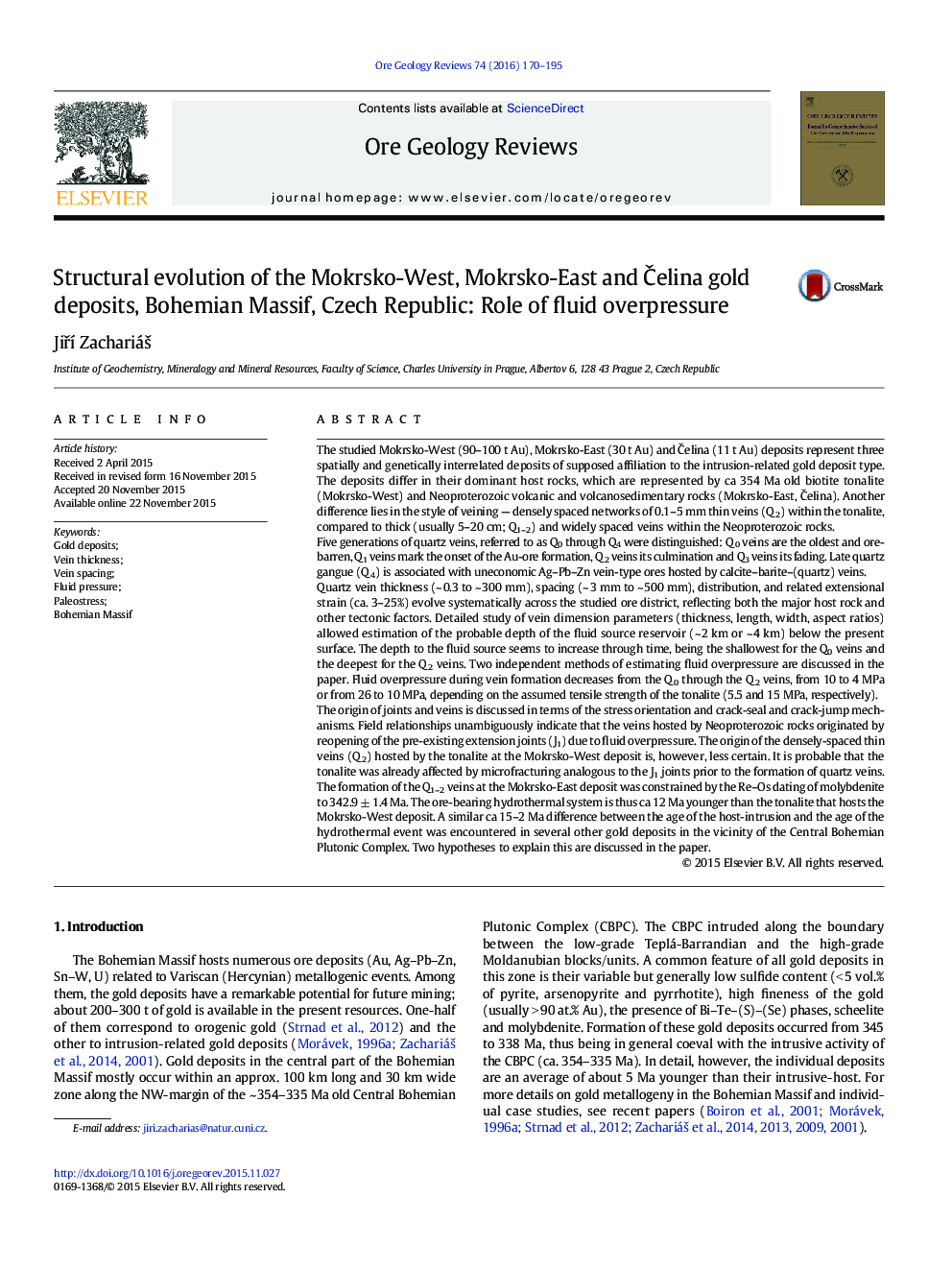| کد مقاله | کد نشریه | سال انتشار | مقاله انگلیسی | نسخه تمام متن |
|---|---|---|---|---|
| 4696831 | 1637232 | 2016 | 26 صفحه PDF | دانلود رایگان |

• Structural evolution and paleostress analysis of a world-class gold deposit
• Reopening of preexisting fractures due to fluid overpressure
• Indirect evidence for a deep fluid source
• Absolute age-disproportion between the ore and the intrusion-host
The studied Mokrsko-West (90–100 t Au), Mokrsko-East (30 t Au) and Čelina (11 t Au) deposits represent three spatially and genetically interrelated deposits of supposed affiliation to the intrusion-related gold deposit type. The deposits differ in their dominant host rocks, which are represented by ca 354 Ma old biotite tonalite (Mokrsko-West) and Neoproterozoic volcanic and volcanosedimentary rocks (Mokrsko-East, Čelina). Another difference lies in the style of veining — densely spaced networks of 0.1–5 mm thin veins (Q2) within the tonalite, compared to thick (usually 5–20 cm; Q1–2) and widely spaced veins within the Neoproterozoic rocks.Five generations of quartz veins, referred to as Q0 through Q4 were distinguished: Q0 veins are the oldest and ore-barren, Q1 veins mark the onset of the Au-ore formation, Q2 veins its culmination and Q3 veins its fading. Late quartz gangue (Q4) is associated with uneconomic Ag–Pb–Zn vein-type ores hosted by calcite–barite–(quartz) veins.Quartz vein thickness (~ 0.3 to ~ 300 mm), spacing (~ 3 mm to ~ 500 mm), distribution, and related extensional strain (ca. 3–25%) evolve systematically across the studied ore district, reflecting both the major host rock and other tectonic factors. Detailed study of vein dimension parameters (thickness, length, width, aspect ratios) allowed estimation of the probable depth of the fluid source reservoir (~ 2 km or ~ 4 km) below the present surface. The depth to the fluid source seems to increase through time, being the shallowest for the Q0 veins and the deepest for the Q2 veins. Two independent methods of estimating fluid overpressure are discussed in the paper. Fluid overpressure during vein formation decreases from the Q0 through the Q2 veins, from 10 to 4 MPa or from 26 to 10 MPa, depending on the assumed tensile strength of the tonalite (5.5 and 15 MPa, respectively).The origin of joints and veins is discussed in terms of the stress orientation and crack-seal and crack-jump mechanisms. Field relationships unambiguously indicate that the veins hosted by Neoproterozoic rocks originated by reopening of the pre-existing extension joints (J1) due to fluid overpressure. The origin of the densely-spaced thin veins (Q2) hosted by the tonalite at the Mokrsko-West deposit is, however, less certain. It is probable that the tonalite was already affected by microfracturing analogous to the J1 joints prior to the formation of quartz veins.The formation of the Q1–2 veins at the Mokrsko-East deposit was constrained by the Re–Os dating of molybdenite to 342.9 ± 1.4 Ma. The ore-bearing hydrothermal system is thus ca 12 Ma younger than the tonalite that hosts the Mokrsko-West deposit. A similar ca 15–2 Ma difference between the age of the host-intrusion and the age of the hydrothermal event was encountered in several other gold deposits in the vicinity of the Central Bohemian Plutonic Complex. Two hypotheses to explain this are discussed in the paper.
Figure optionsDownload as PowerPoint slide
Journal: Ore Geology Reviews - Volume 74, April 2016, Pages 170–195